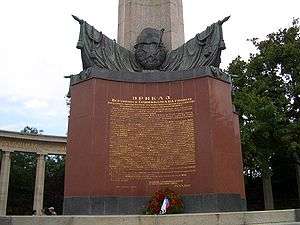Soviet War Memorial (Vienna)
The Soviet War Memorial in Vienna, more formally known as the Heldendenkmal der Roten Armee (English: Heroes' Monument of the Red Army) is located at Vienna's Schwarzenbergplatz. The semi-circular white marble colonnade partially enclosing a twelve-metre figure of a Red Army Soldier was unveiled in 1945.[1] The Heroes' Monument of the Red Army in Vienna was built to commemorate 17,000 Soviet soldiers who were killed in action during the Vienna Offensive in World War II.[2]
| Soviet War Memorial | |
|---|---|
Heldendenkmal der Roten Armee | |
| Soviet Union | |
Soviet War Memorial | |
| For Soviet war dead of the Vienna Offensive | |
| Unveiled | August 19, 1945 |
| Location | 48°11′53.27″N 16°22′34.21″E |
| Designed by | S.G. Yakovlev |
| Commemorated | 17,000 |
Eternal Hail to the heroes of the Red Army who fell in battle against the German fascist invaders for the freedom and Independence of the peoples of Europe. | |
Background
Near the end of World War II, Soviet forces of the 3rd Ukrainian Front were ordered by Joseph Stalin to capture Vienna, both for strategic military purposes and for use as a post-war bargaining chip with the Allies.[3] After intense urban fighting, Vienna was captured by the Soviet Forces on 14 April 1945.[3]
Construction and Austrian perception
| External image | |
|---|---|
The creation of an Allied Commission for Austria was envisaged by Allied leaders at the various sessions of the European Advisory Commission and established by the Agreement on control machinery in Austria in London on July 4, 1945. The agreement mandated the creation of four occupation zones (American, British, French and Soviet) in Vienna, similar to Berlin.[4] Perhaps not coincidentally, although several sites were considered for the Soviet memorial, ultimately a prominent location in the 3rd district near the Palais Schwarzenberg was chosen, imposingly within sight of the location used by the four allies to govern Vienna. German prisoners of war and Austrian construction workers were used to build the 3,000-square-foot (280 m2) site.[5]
The memorial includes a triumphal arch and is dominated by the figure of a soldier with a PPSh-41 submachine gun on his chest. The soldier wears a golden helmet and holds a Soviet flag and a golden Soviet coat of arms.[2] Russian President Vladimir Putin visited the memorial in 2007 to lay flowers and specifically give thanks to Austria for maintaining it.[6] The city paid to refurbish the memorial,[7] despite objections from certain members of the local press.[8]
Vandalism
The monument has been attacked by acts of politically inspired vandalism increasingly in the 21st Century.
- In April 2012 red paint was thrown over a part of the memorial.[9]
- In May 2014 it was daubed with the colours of the Ukrainian flag during the onset of the Russian military intervention in Ukraine.[10]
- In February 2015 black paint was poured over an order on the monument from Joseph Stalin congratulating Soviet Forces on their victory in the Vienna Offensive in 1945.[11]
- In January 2017 the memorial was attacked with red paint being thrown across the inscription of its central column.[12]
Stone tablet text

The text of the stone tablet in front of the monument begins:
Monument to the soldiers of the Soviet Army, who for the liberation of Austria from fascism have fallen....
See also
References
- (in German) Heldendenkmal der Roten Armee, www.nachkriegsjustiz.ag, Retrieved April 3, 2011.
- Chernov, Sergey, "Austrian Capital Preserves Imperial Ambience", The St. Petersburg Times, January 26, 2010, Retrieved April 3, 2011.
- Glantz, David, The Soviet-German War 1941-1945 Archived 2011-06-17 at the Wayback Machine Clemson University, October 11, 2001. Retrieved April 2, 2011.
- Grew, Joseph C., Foreign Relations of the United States, 1945, vol. III, May 7, 1945. p. 116-117
- Czeike, Felix, Historisches Lexikon Wien, Band 5, Kremayr & Scheriau, Wien 1997, ISBN 3-218-00547-7, page 311.
- (in German) Putin verabschiedet sich, DiePresse.com, May 24, 2007, Retrieved April 3, 2011.
- (in German) 3D-Vermessung des Heldendenkmals der Roten Armee, www.netzundplan.at, (refurbishment contractor), Retrieved April 3, 2011.
- (in German) Mädchenmord und Attentate, Öffentliche Sicherheit, January–February 2006, Retrieved April 3, 2011.
- 'Russia outraged at desecration of a monument to Soviet Soldiers in Vienna'. 'News Pepper.su', 13 April 2012. https://www.newspepper.su/news/2012/4/13/russia-outraged-desecration-of-a-monument-to-soviet-soldiers-in-vienna/
- 'Moscow demands Austria eliminates damage to the memorial to Soviet soldiers in Vienna', 'Russia Beyond the Headlines', 8 May 2014. https://rbth.com/news/2014/5/8/moscow_demands_austrai_immediatel_eliminates_damage_to_memorial_of_sovie_36532.%5B%5D
- Ruskiy Mir Foundation news site, 'Soviet War Memorial in Vienna Vandalized', 23 February 2015. http://russkiymir.ru/en/news/185737/
- 'Monument honouring WWII Soviet ear soldiers desecrated in Vienna, again.', 'Russia Today', 16 January 2017. https://www.rt.com/news/373882-soviet-monument-vienna-desecrated/
| Wikimedia Commons has media related to Heldendenkmal der Roten Armee. |